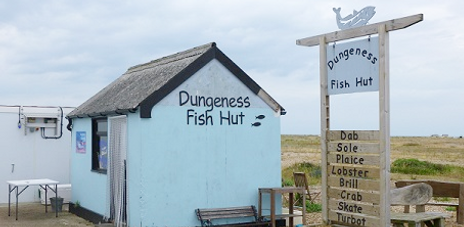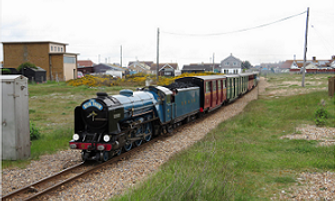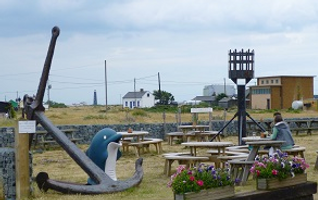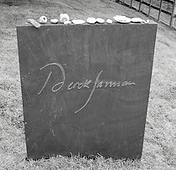

Full-day country walks in
SE England and beyond
Dungeness
Click on the image below to access
the full map on plotaroute
Distance: 4.9 miles.
Time without long breaks: 3 hours.
Terrain: Easy, although shingle underfoot in places.
How to get there and back: Buy a return ticket to Folkestone Central (fast trains run from St Pancras). Then get a cab or catch a bus to Hythe Light Railway Station (the No 10 runs hourly from Shorncliffe Road. Buses No 16, 102 and 103 also go there). Then travel to Dungeness on the Romney. Hythe and Dymchurch railway (check here for train times). Return either on the light railway or on a No 11 bus to Ashford International. Another way is to get a slow train to Sandling from Charing Cross and walk to Hythe station (about 1 3/4 miles). Alternatively, you can change at Ashford and get a train to Appledore to go to the wonderful Red Lion pub at Snargate. From here, you'd need a cab to take you to Dungeness.
Pubs: The Britannia at Dungeness and The Pilot at Lydd-on-Sea.
More information: If you want to visit Prospect Cottage, you need to pre-book. The Denge Sound Mirrors are not normally accessible (although you can see them). If you'd like a closer visit, check here for open days.

Dungeness is a peninsula on the south-east coast of Kent and one of the largest expanses of shingle in Europe. Accessed via a light steam railway, the area, a national nature reserve, has a unique ecology. It has its own micro-climate and the lack of rainfall here has led to it being dubbed 'Britain's only desert'. As well as a huge variety of plant-life, Dungeness is one of the best habitats in the country for invertebrates such as bees, beetles and moths, many species of which are not found elsewhere. It is also a great place for bird-watching and has an RSPB reserve. The wooden shacks along the beach include one which was owned by the film-maker Derek Jarman (see panel below). This walk also takes in the 'sound mirrors', strange brutalist concrete structures which were built before World War II to serve as a rudimentary radar system.
Our advice is to jump in a cab at the rank outside Folkestone station for the five-mile journey to Hythe. If catching a bus, get off at the stop for the light railway station. You can also walk to Hythe from Sandling (on the slow Folkestone line). Either head straight down the road or via the disused railway track to Saltwood, which has an impressive castle, owned by former MP Alan Clarke. If you have time to spend in Hythe – either on your way to Dungeness or on your return – and are not too squeamish, you can visit the remarkable ossuary at St Leonard's Church, which contains over 2,000 skulls from the medieval period. From Hythe, get a train to Dungeness on the Romney, Hythe and Dymchurch Railway.

The Old Lighthouse opened in 1904 but was decommissioned following the construction of the power stations, as they obscured its light beams. It is now a museum and you can climb right to the top of the 150-foot tower, which offers fantastic views of the peninsula. If you are interested in birdwatching, incidentally, and prebook, you can visit the Dungeness Bird Observatory, which is located by a row of old coastguard cottages (turn left when leaving the lighthouse and walk up Dungeness Road). To continue on the walk, take a right. Behind the lighthouse you will see a round building, which once formed the bottom of the 1792 lighthouse and was later turned in lighthouse keepers' dwellings.

A short way up from the cottage, the road bends to the left and then goes across the railway track. You can either follow the road or cut straight across the shingle to reach The Pilot Inn. If following the road, walk up to the junction. You will see a row of coastguard cottages to your left. Turn right at the junction to walk down to the pub. The Pilot is situated exactly half-way through the walk so a good place to have a break. The beer garden features a two-ton wrought iron anchor. After leaving the pub, carry on walking up the coast road, passing some more conventional seaside homes. About 2km on, you will come to a car park on your right. Take the residential turning on the left called Taylor Road.

Head back up the causeway to the track and turn left, skirting the holiday camp. After you pass the last row of chalets you will see some bungalows. Turn right through a low wooden fence into Seaview Road. When you reach the end, turn right and you will see a bus stop. The No 11 from here will take you to Ashford International for the train back to London (buses take about 50 mins. Get off at Beaver Bridge Road, five mins walk from the station). Alternatively, walk a few yards further down the road to reach Romney Sands station, where you can catch a train back to Hythe. From there, get a bus/cab to Folkestone or walk to Sandling.

The railway was the brainchild of two racing drivers, J.E.P Howley and Count Louis Zborowski (who also created 'chitty chitty bang bang' cars, which became the inspiration for the film). The line was opened as far as New Romney in 1927 and extended to Dungeness 20 years later. The total distance is about 13 miles and the journey takes an hour. Dungeness station has a cafe and a bar, which is run by the Romney Marsh Brewery. When you leave the station, you will see Dungeness Old Lighthouse ahead of you and Dungeness B nuclear power station to your right. Dungeness A (the older of the two plants) closed in 2012 and Dungeness B is now (as of 2023) in its 'defuelling' phase ahead of its closure in 2028. Unfortunately, it is no longer doing public tours.

Turn right and follow the road along the shoreline, heading towards the New Lighthouse. On your right, you will pass Dungeness Open Studios, a tiny art gallery. A little further on, is the Britannia Inn. After passing the lighthouse, you will see an iron structure on the beach which serves as a shipping navigation guide, and then on your right, you will come to the Fish Hut, which has a selection of fresh fish and seafood About 500m from here, you reach Prospect Cottage, the most famous of the weatherboarded shacks. The film-maker Derek Jarman lived here (see below). The cottage and its unique garden are open to the public, but you must book.

Go right to the end of the road where you will see a sign saying 'Mirrors' and some telegraph poles. Head across the shingle until you reach a disused railway track. Turn right and follow the track that soon runs alongside Denge Lake (this area is Lade Pits, an RSPB nature reserve – the lake was created from a flooded gravel pit). About 1km along you reach the causeway to Denge Sound Mirrors on your left. The concrete structures were built between 1928 and 1935 as an early-warning defence system to detect the sound of approaching aircraft, but they were soon eclipsed by the advent of radar. The mirrors are on an island accessed via a swing bridge and are only accessible on special open days, but you can still see them clearly from here.


Initially a maker of short experimental films, Derek Jarman's feature film career started in the late 1970s with the controversial Sebastiane. He followed this with Jubilee, which was shot during Queen Elizabeth's Silver Jubilee in 1977 and featured many of the punk icons of the era. He became known to a wider audience following the release of his film Caravaggio – based on the life of the Italian artist – in 1986. He was also beginning to make a name as a director of innovative music videos for bands such as the Pet Shop Boys. By this time, Jarman was coming to terms with his HIV diagnosis. Already an outspoken campaigner for gay rights, he spoke openly about dealing with the illness. A year following his diagnosis, he purchased Prospect Cottage, refurbishing the old fisherman's shack, painting it black with yellow window frames and turning it into the home where he would live for the remainder of his life. He also added the inscription on the side of the building, which displays part of John Donne's poem, The Sun Rising.
At his sanctuary by the sea, in addition to film-making, Jarman would indulge his other creative passions, such as painting and writing (he wrote his meditative journal Modern Nature here). He also created the celebrated shingle garden at the cottage, composed of hardy salt-loving plants and sculptures made from driftwood. It formed the backdrop to his 1990 film The Garden, starring Tilda Swinton. When he made his final film Blue, in 1993, Jarman was already dying of AIDS. He passed away in London a year later. His resting place is a few miles away from Dungeness, at St Clement's Church in Old Romney, and is marked by a distinctive modern gravestone. Jarman left Prospect Cottage to his close friend Keith Collins, who supported him throughout his illness. It passed into public ownership following Collins' death in 2018.

Dungeness and Derek Jarman are the subject of an audio exploration by the musician Alexander Tucker called Fifth Continent. Tucker combines his electronic soundscapes with spoken word contributions from Keith Collins, captured before his death. There is also an accompanying anthology called Fifth Quarter, which contains contributions from many of Jarman's friends. KB

Walks by County
Listed by the most traversed
county for each route
Berkshire
Buckinghamshire
Henley circular
Pr. Risborough-Wendover
Tring circular
Tring-Leighton Buzzard
Cambridgeshire
Cambridge-Trumpington
Whittlesford-Wandlebury
Derbyshire
Edale-Hope
Dorset
Corfe Castle-W. Matravers
East Sussex
Ashdown Forest
Berwick circular
Berwick-Seaford
Cuckmere Haven-E'bourne
Forest Row-Eridge
Glynde-Berwick
Glynde-Seven Sisters
Isfield-Lewes
Lewes circular 1
Lewes circular 2
Lewes-Hassocks
Lewes-Rottingdean
Plumpton-Hassocks
Rye-Three Oaks
Gloucestershire
Kingham circular
Toddington-Cleeve Hill
Hertfordshire
Codicote-St Albans
Odsey-Royston
Kent
Oxfordshire
Surrey
West Sussex
Bramber-Amberley
Steyning circular
West Yorkshire
Haworth-Hebden Bridge
Wiltshire
Avebury circular
